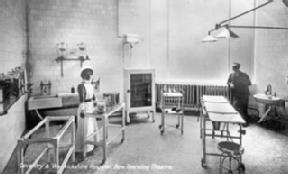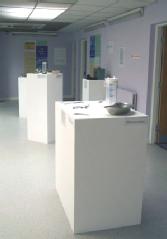The Doctor's Story
 An Era of Great Medical Progress
An Era of Great Medical Progress
Doctors who arrived in Coventry in the late 1940s and early 1950s recall a city that was still visibly in the process of recovering from the blitz, but also because of this a place of opportunity. Many initially had mixed feelings about the advent of a new health service, in which they were to become state employees. Though opposition soon faded, it is notable that the doctors employed at the Coventry and Warwickshire hospital in the post-war decades often took on a small private practice alongside their NHS duties, and often turned to it as something of a relief. Working in the hospital itself was intensely hard, struggling to keep up with demand and having to cope with the often inadequate facilities.
The wartime bombing left the Coventry and Warwickshire Hospital in limbo. Plans for the construction of a new site, raised as early as 1942, were continually delayed, while at the same time renovation of the Stoney Stanton Road site was put on hold. Nevertheless, doctors also recall a series of victories in making improvements to medical provision. This was an era of great medical progress, of an ever-quickening pace of innovation in medical technology in particular. Because of this, the doctors’ stories are not just of the hospital, but also of achievement in the development of new departments and the expansion of specialist services. However, such specialisation created new demands and expectations, dealt with in part by the use of satellite institutions. This, in turn, created difficulties in having to move between sites.
Construction of the long awaited new hospital began at the Walsgrave site in 1965, with several services already relocated before the official opening in 1970. For Dr Thomas Backhouse, there was no comparison between the new hospital and the old – the Walsgrave ‘changed everything really’. In terms of beds and staff, it was now the major hospital for the city. Coventry and Warwickshire Hospital was left to concentrate on out-patient services, accident and emergency, ophthalmology, and orthopaedics.
Patients and Administrators 
Dr Frank Vince, who joined the hospital in 1971 recalls the situation as ‘pretty terrible’. Nevertheless, Dr Vince, like others who worked at the Coventry and Warwickshire over its last 35 years, provides a story of progress overcoming adversity, teamwork with colleagues and staff, and continued fulfilment in the treatment and care of patients.
Like other doctors, he welcomed a new type of relationship with the public. Patients were better informed, less inclined to accept what the doctor said without discussion or reason, and keen ‘to know what the options are and feel that they’re part of any decision’.
Doctors were less positive about a shift in power to administrators and politicians, which they date from the 1970s. In the words of Dr Vince, it had become ‘all paperwork and rules’. Previously there had been a culture where ingenuity and determination was all it took to get things done, but no more. ‘People talk about the money all the time now. We never used to talk about money then, if you wanted something you just did your best to get it’.
<- previous stage of exhibition | next stage of exhibition ->
Exhibition tour:
Doctor's Story
